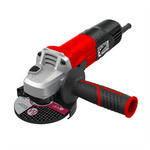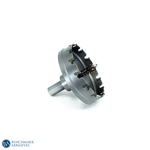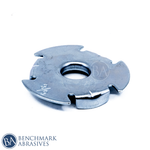
How To Use Wire Wheel For Removing Paint From Wood

Woodworkers are aware of how difficult it is to remove old paint. However, you're in luck if you know how to use a wire brush to remove paint from wood. You can use a wire brush to clean off the edges of freshly cut boards, remove paint from a surface, or remove rust from a metal bed frame.
Wire brushes come in various sizes and materials depending on what you need them for, but they all share one thing: they're excellent at getting into tight spaces that other tools can't reach. This article will discuss how to remove paint with a wire brush.
5 Steps To Remove Paint From Wood With Wire Brush
Step 1: Dry Brush The Wood To Remove Any Loose Paint
Sweeping motions back and forth across the raised or blistered paint is where you want to start the paint removal procedure. To remove the peeling paint from the solid base, first, sweep your paint-stripping brush in the direction of the peeling paint.
Step 2: Apply Solvent Or Thinner To The Paint Remover Brush
Consider adding a layer of paint thinner or solvent to the paint remover brush if any portions of the surface still have paint on them after dry brushing. You could use water or mineral spirits in this.
Brush the paint off immediately as the wire tines cannot contain a liquid thinner or solvent. If you can tell, stroke against the direction of the paint strokes. This enables the brush to saturate the paint, closely clinging to the wood thoroughly.
Similarly, you can immediately apply the solvent or thinner to the paint job you want to remove. Scrub off the paint after it softens. As you keep brushing, you'll notice the brush starting to pick up color. For places with challenging paint, use additional force.
Step 3: Use Several Paint Removal Techniques
Apply a chemical paint remover to the intricate corners, edges, and fragile wood surfaces. The paint on the delicate furniture will soften as a result. Make multiple passes with your brush to remove extra paint and any lingering stripper from the surface after the color begins to form bubbles on the surface. When employing chemical paint removers, strictly adhere to the manufacturer's recommendations.
You can remove the paint by using pressure washing if you work on a sizable exterior area, like a wall siding or deck. Use your wire brush to scrub any remaining tenacious paint off the surface.
Using these two techniques, you may remove paint more quickly while reducing the visibility of surface scratches caused by paint-stripping brushes.
Step 4: If Required, Proceed With A Paint Scraper
Peel off the remaining paint layers with thick paint scrapers. Scrape it from the surface by pushing it under the paint.
Step 5: Clean The Wire Brush
To properly remove paint and debris stuck in the bristles, thoroughly rinse your brush under running water. It should use mineral spirits initially to flex the meeting to release the trash if you remove oil-based paint. Clean-up is completed with hot, soapy water.
Read More: How To Remove Rust From Metal At Home
How To Choose a Wire Brush For Stripping Paint
Among other undesired debris, wire brushes are frequently the best tool for removing flaking paint from wood, rust from metals, slag, and weld spatter from a surface. However, you should take into account the following significant elements before selecting the ideal one for your project:
1. Wire Type
Consider the wire type on your paint removal brush to select the one best suited for the surface material you intend to use. You can have a brass, stainless steel, carbon steel, and nylon wire brush.
Although they are rather picky about the surfaces you should use them on, carbon steel and stainless steel can be used with wood. On the other hand, brass and nylon are adaptable and work particularly well with wooden projects.
2. Wire Diameter
Depending on the paint thickness of your project, an effective paint-peeling wire brush has a different diameter.
Choose a wire brush with a fine or thin diameter for light-duty tasks like painting, detailing, or cleaning mirrors. Otherwise, use a medium to coarse wire brush for more considerable external work or heavy-duty furniture and chairs.
3. Filament Configuration
Three filament configuration choices are available for wire cups, wire wheels, and hand brushes, depending on each of their advantages.
-
Wire brushes with a stringer bead twist knot – To form a knot, the filaments are firmly twisted, narrowing the face and increasing impact—the most effective filament arrangement for vigorous cleaning and brushing.
-
Straight wire bristles are twisted together to form solid and cable-like segments in Standard Twist Knot Wire Brushes. They are best suited for demanding, high-impact applications because of this property.
-
Crimped wire brushes are constructed of separate wires that are held together by one another, making them more flexible and high-impact. These brushes, therefore, work better for light to medium-duty tasks on uneven surfaces and more sensitive surface finishes.
4. Trim Length
The amount of usable filament on your wire brushes is equal to the length of the trim. Therefore, pick a brush with longer trimmings for flexibility on irregular surfaces. For a quicker response on various typical surfaces, choose a shorter, more stiff brush filament.
Tips For Using A Wire Wheel To Remove Paint On Wood
Here are some useful tips for using a wire wheel to remove paint from wood:
-
Type of wire wheel: selecting the right type of wire wheel is essential for removing paint. For stubborn paint, use knotted wheels, as these are aggressive and remove paint quickly. For delicate jobs, use crimped wheels, as these are gentle on surfaces. Also, consider the thickness and sharpness of the wheel based on the material to be removed.
-
Power Tools: selecting the right type of power tools will also help in removing paint from the wood. For example, angle grinders are better for aggressive material removal and offer more power. Drills, On the other hand, are suitable for precision and fine results. Always choose the power tool according to the desired outcome and which suits your expertise.
-
Apply gentle pressure: always apply gentle or light pressure while working with wire brushes. Excessive pressure can lead to damage to the wire wheel as well as the workpiece.
-
Take a break: always take a break when working for long hours, as it will cause overheating and damage the wheel. Taking a break allows the wheels to cool down and is also good for you to rest for a few minutes.
-
Selecting the right technique: choosing the right technique is also essential when working with wood. For example, softer wood requires a more gentle technique compared to hardwood. The type of paint to remove also helps in choosing the technique.
-
Safety tools: always choose the right safety tools for using wire wheels. This ensures the safety of the user as well as the surroundings.
CONCLUSION
Refinishing old wooden surfaces should be a breeze if you know how to remove paint from wood using a paint-stripping brush. Be aware that it can also remove painting metal with a wire brush. For quickly and affordably removing paint from wood, use wire brushes. There are two types of these brushes: manual and power-driven. You now have everything you need to complete the paint removal job. Good luck with the painting.



































































